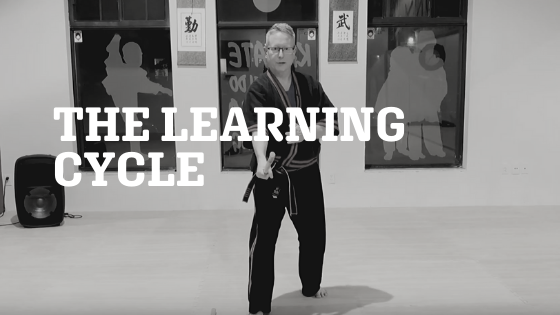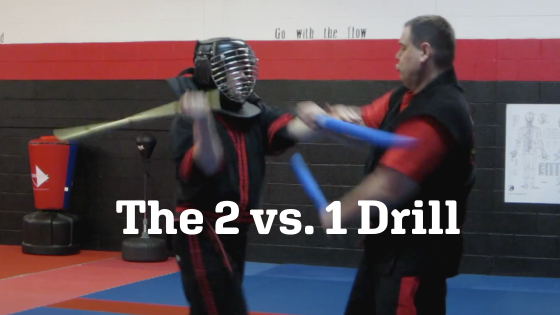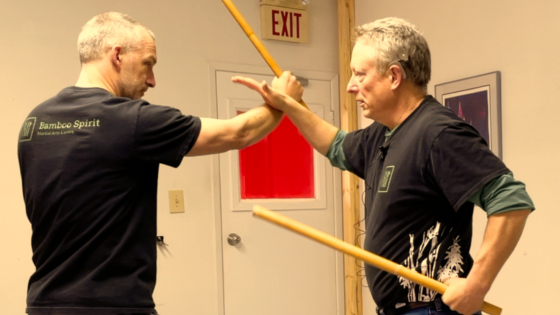The Learning Cycle
As many of you know, I like teaching flow drills. I find it a practical and fun way to introduce the concepts of Modern Arnis. I find this a useful addition to a student’s learning cycle. The concepts range from abanico corto, palis palis, disarms, clearing, stick locking, switching hands, footwork, and much more.
These drills keep both partners busy and reduce excessive socializing during class. It is more interactive than the one-step technique sequence typical to so many martial arts schools.
However, to learn the flow drills, one must learn the basics. Among the basics that one must learn before being introduced to the first drill are the following:
- the 12 angles of attack;
- blocking;
- footwork;
- block, check, and counter;
- obstruction removal (aka slap off/pull off)
- tapi tapi block
Once the students are comfortable with the basics, I introduce them to the first drill, which serves as the template for the remaining 19 flow drills in my program.
My approach has evolved over the years. I impart the basics to teach the “mother drill.” Then I use the drills to teach the fundamentals. It has taken me a while to get to this point, and I still have a ways to go as a teacher. But, I like where I am compared to 2008 when I first started teaching here.
One impetus toward teaching the flow drills is that most of my students attend one class a week. Such is life in a busy metropolitan area like the Greater Toronto Area. This impacts their learning curve. Rarely do I see a student attend twice a week. Once a week is a norm for most students.
Often, students will miss class due to professional obligations, family life, changing jobs, and other factors. Some have just enough energy to attend once a week. The commute in the Toronto area can be as much as two hours for many.
As a result, I have steadily shifted toward using flow drills as the basis for nearly every class.
Nearly every flow drill that I teach has the same basic template. They are easy for many to remember. The usual progression for a class is a breakdown of the significant component of the drill. Then do the drill. Maybe a variation or two of the drill.
The beautiful thing is that I use the flow drills to reinforce the basics, such as a clean post block, correct footwork, and proper form. Some students are going to have cleaner fundamentals than others. Some take longer to polish up. That’s okay because not everyone progresses at the same pace.
Applications come into play as well. For example, a couple of weeks ago, I went over the applications of the pulling motion of Flow Drill 3. I transitioned into various counter-pulling techniques and how they can apply to empty-hand situations. That was a fun class! 🙂
I have used the flow drills to teach sensitivity, as well. Here’s an example from one of my flow drills:
If you can’t see the video, click here.
Many have told me that they love the flow drills, and there is so much you can teach from them. It allows me to keep things simple and not have my students memorize 200 techniques. I try to keep it simple.
Keeping it simple is critical for students who can come to class just once a week. Over time, through the flow drills, they learn the central concepts of Modern Arnis. While I’m still tweaking my teaching approach, I have increasingly settled on this as an effective way to teach my students and nothing can budge me from this belief.
Over to you, what do you incorporate into your classes to enhance the learning cycle? Let’s hear it from you!
Share this post:
- Click to share on Twitter (Opens in new window)
- Click to share on Facebook (Opens in new window)
- Click to share on LinkedIn (Opens in new window)
- Click to share on WhatsApp (Opens in new window)
- Click to share on Nextdoor (Opens in new window)
- Click to share on Pinterest (Opens in new window)
- Click to email a link to a friend (Opens in new window)
Tags In
Brian Johns
Related Posts
6 Comments
Leave a Reply Cancel reply
Categories
- Arnis/Kali/Eskrima (113)
- Book Review (8)
- DVD Reviews (3)
- Guest Post (4)
- Inspiration (24)
- Martial Arts (99)
- My story (92)
- Safety (14)
- Tips & tricks (6)
- Uncategorized (3)
- YouTube Videos (8)






[…] While teaching one-step techniques has its place, there are limitations to this method. The most severe limitation, in my opinion, is that the one-step method does not develop the flow. If students stop and reset for every repetition of a technique, they never really learn the flow. […]
[…] I have mentioned that they are not combative. Instead, they are designed for the student to learn the major concepts of Modern Arnis and attributes such as spontaneity, adaptability, tempo, rhythm, speed, timing, […]
[…] develop tremendous skills needed for single-stick fighting. At a basic level, a practitioner will learn how to develop […]
[…] checking, this drill teaches footwork, body shifting, blocking, striking, and recognizing the angles of your opponent’s […]
[…] The Learning Cycle […]
[…] The Learning Cycle […]